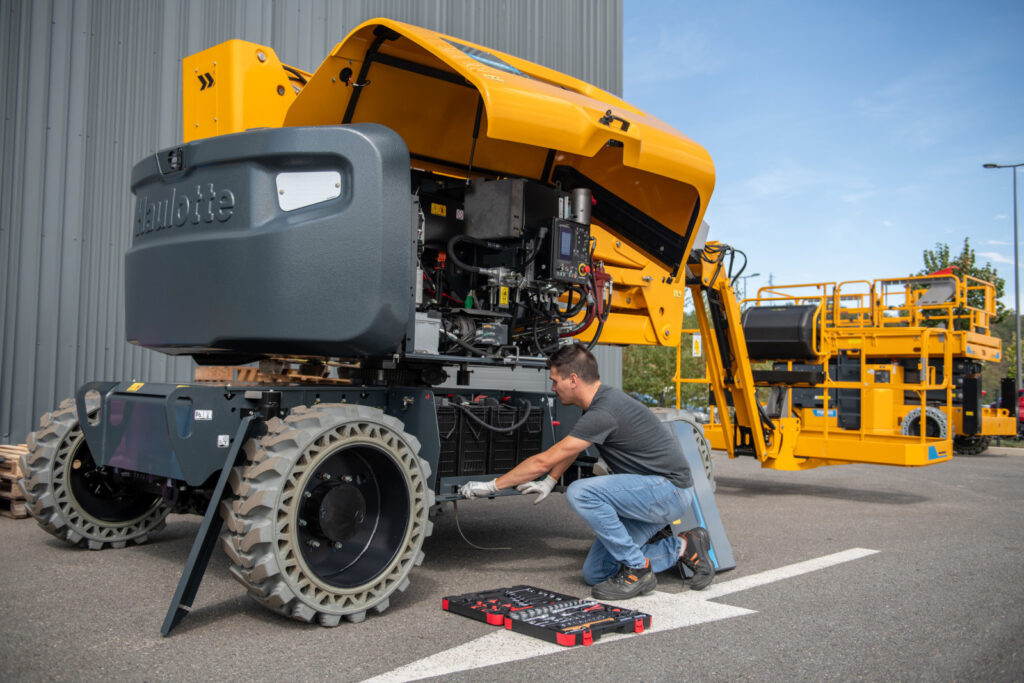Mobile Elevating Work Platforms (MEWPs) are complex and essential machines in the construction industry. With safety as a top priority on job sites, regular inspections of construction and lifting equipment are mandatory. These inspections not only prevent accidents but also ensure compliance with ever-evolving standards.
What is a Periodic General Inspection?
Periodic general inspections are a cornerstone of a quality and safety-focused approach to equipment management. The purpose of these inspections is to identify and rectify anomalies or malfunctions that could pose a danger to operators or other workers. By ensuring the condition and conformity of your equipment, you:
- Reduce the risk of accidents.
- Protect the safety of your team and customers.
- Safeguard the continuity of your operations.
It is critical that these inspections are conducted by qualified professionals. Opting for an accredited external inspection body guarantees expertise and reliable results.

Updates on Standards and Guidelines
ISO 18893:2024
A major development in the industry is the introduction of ISO 18893:2024, which outlines safety principles, inspection, maintenance, and operation requirements for MEWPs. Applicable to both new and in-service equipment, this standard provides clear guidelines on:
- Selection and safe operation of MEWPs.
- Inspection and maintenance protocols.
- Responsibilities for manufacturers, owners, and operators.
- Framework for verifying compliance with safety standards.
This standard aims to reduce accidents, protect workers, and establish a benchmark for governmental regulations.
Major Inspections
In addition to periodic inspections, the International Powered Access Federation (IPAF) emphasizes the importance of major inspections. These are crucial for machines nearing or exceeding their designated design life. These inspections validate the structural integrity and functionality of critical components, ensuring continued safe operation.
How is a Periodic General Inspection conducted?
The periodic general inspection of MEWPs involves two main stages:
- Visual Examination
Before operation, the inspector assesses the general condition
of the machine, including:
- Overall appearance (e.g., signs of corrosion or cracks).
- Chassis (wheels, protective parts, counterweight).
- Power unit and control panel.
- Hydraulic components such as cylinders, hoses, and safety valves.
- Functional Tests
The second stage involves verifying the machine’s functionality, including:
- Controls, brakes, and lighting.
- Stability and load capacity.
- Proper operation of all safety systems.
At the end of the inspection, a detailed report is issued. This report must remain accessible with the machine. Equipment cannot be put into service until all identified issues are resolved.
Comprehensive service, inspection, and maintenance
IPAF outlines three critical elements to ensure MEWPs remain in safe working condition throughout their lifespan:
- Pre-use inspections: Conducted by competent operators before each use.
- Scheduled servicing and maintenance: Following the MEWP manufacturer’s guidelines.
- Periodic Inspections: To ensure ongoing compliance and safety.
Each element plays an integral role in maintaining equipment reliability and operator safety.

Frequency of Inspections
The frequency of periodic general inspections depends on local regulations. For example:
- France: Every 6 months.
- United States: Maximum interval of 13 months, per ANSI standards.
Additionally, inspections are mandatory after major repairs or when equipment is put back into service following a period of inactivity.
Why These Inspections Are Essential
Periodic general inspections, alongside adherence to ISO 18893:2024, help limit risks, prevent accidents, and ensure the long-term reliability of MEWPs. While these inspections are crucial, they do not replace the maintenance schedules recommended by manufacturers.
By aligning your practices with the latest standards and embracing a proactive approach to equipment safety, you can confidently navigate the challenges of the modern construction industry while prioritizing the well-being of your workforce.